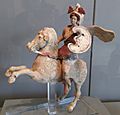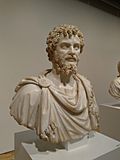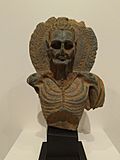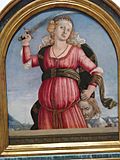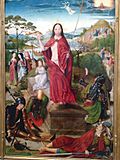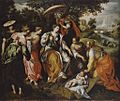Eskenazi Museum of Art facts for kids
 |
|
| Established | 1941 |
|---|---|
| Location | 1133 E 7th St, Indiana University, Bloomington, Indiana |
| Type | Art Museum |
The Sidney and Lois Eskenazi Museum of Art is a famous art museum located on the campus of Indiana University Bloomington. It first opened in 1941 and was led by its first director, Henry Radford Hope.
Today, the museum is in a special building designed by the world-famous architect I.M. Pei. This building opened in 1982. The museum holds a huge collection of about 45,000 artworks, from ancient jewelry to modern paintings by artists like Pablo Picasso and Jackson Pollock.
In 2016, the museum received a very large donation from Sidney and Lois Eskenazi. To honor their gift, the museum was renamed after them. You can find the museum at 1133 E. Seventh Street on the university campus.
Contents
The Museum's Story
How It All Began
The Eskenazi Museum of Art started in 1941 in a small gallery at Indiana University. The first director, Henry Radford Hope, wanted to bring art to the campus for students to study and enjoy. The first exhibition featured local artists from Brown County, Indiana.
The goal was to show many different kinds of art, both old and new.
Building a Collection
After World War II, the museum began to collect art for a permanent collection. In 1955, collectors James and Marvelle Adams donated a terracotta bust by the artist Aristide Maillol. This gift inspired Hope to focus on building a lasting collection.
In the early years, many important artworks were purchased with money from a special fund. Hope also donated art from his own collection, including a painting by Pablo Picasso. Many people gave art to the museum in the 1950s, 60s, and 70s, helping it grow quickly.
A Brand New Building
By 1962, the museum had moved into a larger space in the university's Fine Arts building. As the collection grew, it became clear that the museum needed its own building.
In 1971, Thomas T. Solley became the new director. He was also an architect and was the perfect person to lead the project. In 1974, the museum hired the famous architect I.M. Pei to design the new building. The building, which opened in 1982, had plenty of space for the museum's art. Under Solley's leadership, the collection grew from 4,000 to 30,000 items.
Recent History
Adelheid M. Gealt became the director in 1987 and served until 2015. After her, David A. Brenneman took over as director.
In 2016, Sidney and Lois Eskenazi gave $15 million to the museum. This generous gift was used to completely renovate the I.M. Pei building. The museum closed in 2017 for the renovations and reopened to the public in November 2019 with a fresh, updated look.
In late 2023, the museum canceled a planned art show for artist Samia Halaby. University officials stated the cancellation was due to concerns about the exhibit. The decision was questioned by free expression groups, who asked the university to put the show back on. The art show was later hosted by the Broad Art Museum at Michigan State University.
What's Inside: The Collections
The museum has four main galleries where it displays its permanent collection. These galleries show art from different time periods and places around the world. There are also three other galleries for special exhibitions that change throughout the year.
- Ancient, Asian, and Islamic Art: In this gallery, you can see ancient Chinese porcelain, Japanese paintings, and art from classical Greece and Rome. It also features the Burton Y. Berry Collection of Ancient Jewelry, which has over 5,000 pieces.
- European and American Art: This collection includes paintings by European masters like Claude Monet and modern American artists like Frank Stella.
- Art from Around the World: The Raymond and Laura Wielgus Gallery features art from Africa, Oceania (the islands of the Pacific Ocean), and the Indigenous peoples of the Americas.
- Works on Paper: The museum has a large collection of prints, drawings, and photographs. It includes works by famous artists like Albrecht Dürer and Rembrandt van Rijn.
-
Cycladic, attributed to the Goulandris Master. Woman, ca. 2500–2400 BCE. Eskenazi Museum of Art, Indiana University, 76.25
-
Greek. Amazon Riding Horse, 330–280 BCE. Terracotta, added color, and gold. Eskenazi Museum of Art, Indiana University, 81.8
-
Roman. Bust of Emperor Septimius Severus, 200–210 CE. Marble, 30 5/16 in. Gift of Thomas T. Solley, Eskenazi Museum of Art, Indiana University, 75.33.1
-
Gandharan. Fasting Buddha, 2nd–3rd century CE. Schist with traces of gilding, 9 7/8 x 7 x 3 1/8 in. Eskenazi Museum of Art, Indiana University, 79.53
Learning and Fun at the Museum
The museum offers many educational programs for students. Each year, about 7,000 students from all over Indiana visit the museum. University students also use the museum for their classes.
There are also fun public programs, like talks with visiting artists and "Art and a Movie" nights. The museum also offers guided tours and social events for friends and families.
The Museum's Unique Building
The museum's building, designed by I.M. Pei, is famous for its interesting angles. Some people say it has no 90-degree angles, but that's just a rumor! The design is made of two large concrete triangles connected by a bright, glass-roofed atrium.
The building is very large, with lots of gallery space, offices, a gift shop, and an outdoor Sculpture Terrace.
Café and Gift Shop
On the second floor, you can visit the Luzetta and Del Newkirk Café and Gift Shop. You can buy art-themed gifts and enjoy food and drinks. There is seating inside and outside on the Sculpture Terrace.
In the café, look up to see a cool art installation called A Gust of Wind by designer Paul Cocksedge. It's made of pieces of acrylic that look like white paper being blown into the museum.
The Amazing Light Totem
Outside the museum stands the Light Totem, a 70-foot tower of light. It was created by artist Robert Shakespeare in 2007 for the museum's 25th anniversary. It was so popular that it became a permanent part of the museum.
The tower is lit by LEDs (light-emitting diodes) that can project any color and change every tenth of a second. The lights create a colorful, computerized display on the museum's wall. It's a popular spot for students to hang out and watch the changing colors.



